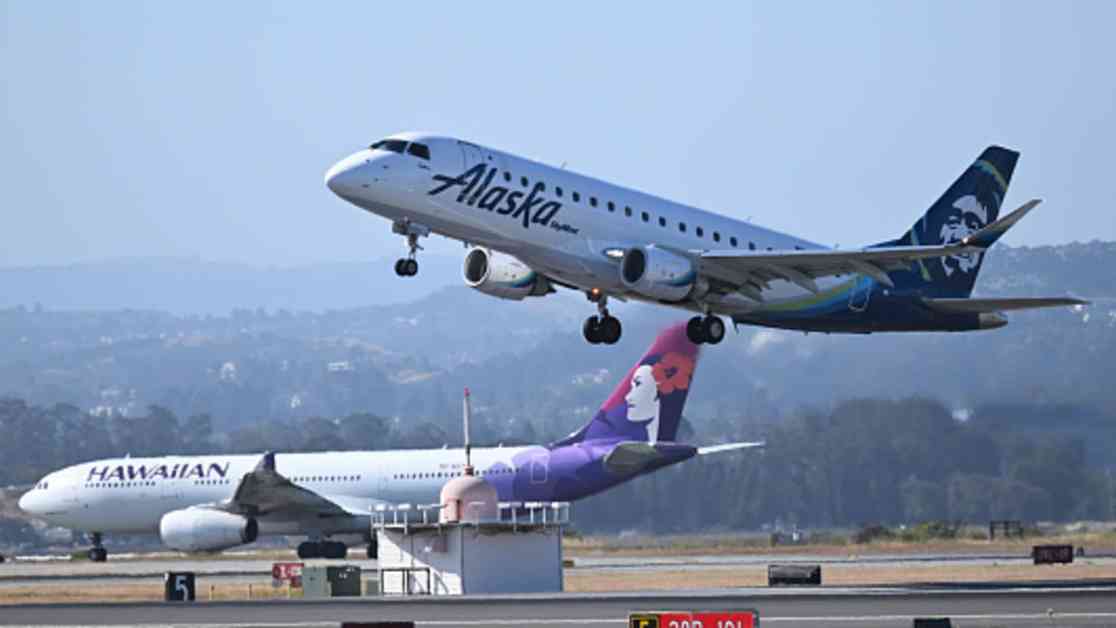Alaska Airlines and Hawaiian Airlines Merger Cleared by DOJ, Awaits DOT Approval
Alaska Airlines and Hawaiian Airlines have reached a significant milestone in their planned merger, as the U.S. Department of Justice has cleared the deal after the antitrust investigation period ended without any lawsuits to block it. The acquisition, valued at $1.9 billion, was announced by the two carriers eight months ago and is now moving forward to the next phase of approval by the U.S. Transportation Department.
The merger between Alaska Airlines and Hawaiian Airlines would mark the largest consolidation of U.S. carriers since Alaska merged with Virgin America back in 2016. Both airlines have expressed optimism about the potential benefits and synergies that the combination could bring to their operations and customers.
Alaska Airlines released a statement confirming the DOJ’s completion of its regulatory investigation under the Hart-Scott-Rodino Antitrust Improvements Act. The airlines stated, “This is a significant milestone in the process to join our airlines.” The next step for Alaska and Hawaiian Airlines is to seek approval from the U.S. Transportation Department before finalizing the deal, although the timeline for this review process remains unclear at this time.
The recent court ruling that blocked JetBlue Airways’ acquisition of Spirit Airlines and the DOJ’s successful suit against the partnership between JetBlue and American Airlines underscore the regulatory scrutiny facing airline mergers in the current market environment. Despite these challenges, Alaska and Hawaiian Airlines appear to be making progress towards completing their merger.
Hawaiian Airlines has faced various obstacles leading up to the merger announcement, including the devastating Maui wildfires, increased competition from Southwest Airlines, and the slower recovery of travel to and from Asia following the Covid-19 pandemic. Despite these challenges, Hawaiian Airlines executives have noted improvements in booking trends recently, signaling a potential turnaround for the carrier.
In the midst of a challenging operating environment for airlines, Hawaiian Airlines has reported net losses in all but one quarter since the beginning of 2020. However, the airline’s shares have experienced a nearly 12% increase this quarter, outperforming many other carriers in the industry. This positive trend could bode well for Hawaiian Airlines as it navigates the final stages of the merger process with Alaska Airlines.
When the merger was first announced in December, Alaska and Hawaiian Airlines stated their intention to maintain both carriers’ brands while operating under a unified platform. The combined fleet of over 360 aircraft would serve more than 130 destinations, offering passengers a wider range of travel options and enhanced connectivity across the two airlines’ networks.
As Alaska and Hawaiian Airlines await the U.S. Transportation Department’s review and approval, the aviation industry will be closely monitoring the progress of the merger and its potential implications for the competitive landscape. Both airlines are optimistic about the synergies and growth opportunities that the combination could bring, positioning them for a stronger future in the post-pandemic travel market.
Implications for Passengers
For passengers, the merger between Alaska Airlines and Hawaiian Airlines could offer a range of benefits, including expanded route networks, increased flight frequencies, and improved connectivity between the two carriers’ destinations. The combined fleet of aircraft would provide passengers with more options for travel and potentially lower fares due to economies of scale and operational efficiencies.
Additionally, passengers flying with Alaska or Hawaiian Airlines may benefit from enhanced loyalty programs, shared amenities, and a seamless travel experience across both airlines’ networks. The merger could lead to improved customer service, streamlined booking processes, and a more cohesive travel experience for passengers flying with either carrier.
By joining forces, Alaska and Hawaiian Airlines aim to create a stronger, more competitive airline that can better withstand market challenges and capitalize on growth opportunities in the evolving aviation industry. For passengers, this could mean more choices, better service, and enhanced travel experiences when flying with either Alaska or Hawaiian Airlines.
Regulatory Approval Process
The completion of the U.S. Department of Justice’s regulatory investigation marks a significant step forward for Alaska Airlines and Hawaiian Airlines in their merger journey. With the antitrust hurdle cleared, the airlines must now secure approval from the U.S. Transportation Department before finalizing the deal and officially merging their operations.
The U.S. Transportation Department’s review process will involve assessing the potential impact of the merger on competition, consumer choice, and airfares, among other factors. The approval process is essential to ensure that the merger complies with regulatory requirements and does not harm consumers or reduce competition in the aviation market.
While the timeline for the U.S. Transportation Department’s review remains uncertain, Alaska and Hawaiian Airlines are committed to working closely with regulators to address any concerns and gain approval for their merger. The airlines’ successful completion of the DOJ’s regulatory investigation bodes well for their prospects of securing final approval from the DOT and moving forward with their planned combination.
Industry Consolidation Trends
The merger between Alaska Airlines and Hawaiian Airlines reflects broader consolidation trends in the airline industry, as carriers seek to strengthen their competitive positions, achieve economies of scale, and navigate the challenges of the post-pandemic travel market. In recent years, airlines have pursued mergers and acquisitions to streamline operations, expand route networks, and enhance their market presence.
The Alaska-Hawaiian merger is part of a wave of consolidation in the airline industry, following previous mergers such as Alaska’s acquisition of Virgin America and the merger of United Airlines and Continental Airlines. These consolidation efforts aim to create stronger, more resilient airlines that can better compete in a rapidly changing market environment and deliver value to customers and shareholders.
As airlines continue to face ongoing challenges, including fluctuating demand, rising fuel costs, and regulatory scrutiny, mergers and acquisitions are seen as strategic tools to drive growth, improve efficiency, and bolster competitiveness. By joining forces, Alaska and Hawaiian Airlines are positioning themselves for long-term success and sustainability in a dynamic and evolving industry landscape.
Overall, the merger between Alaska Airlines and Hawaiian Airlines represents a significant development in the airline industry, with implications for passengers, regulators, and industry stakeholders alike. As the airlines move forward with the regulatory approval process and prepare to combine their operations, the industry will be watching closely to see how this merger unfolds and what it means for the future of air travel.






















